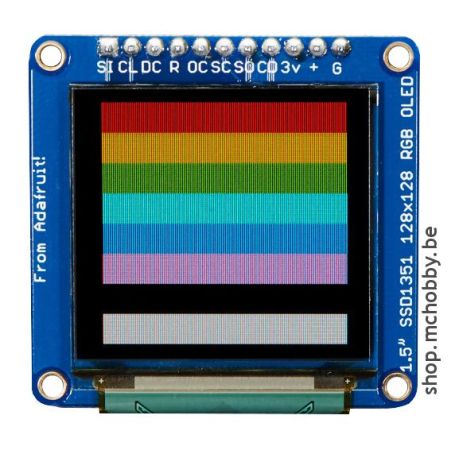Graphic OLED display 128x128 -16 bits colors
OLED RGB graphical display
- 1.5" diagonal
- 128 (RGB) x 128 pixels
- 16 bits colors
- SPI bus
- microSD connector
Payments are secured by LyraCollect, a French payment collection company.
It is possible to delivered to your home, to a pick-up point or picked up by appointment at MCHobby
We prepare, pack and ship your orders with great respect and care.
A small RGB OLED display for a highly integrated project
Having a black and white monochrome display is really cool but if you'd like to add some color this screen would fulfill your wish. This is the big 1.5" color OLED displays from Adafruit. It is perfect to show vivid 16 bits colors with a very high contrast. The visible portion of the OLED has a diagonal of 1.5" (38mm) and contains 128x128 RGB pixels. Each pixel is made of one red, one green and one blue OLEDs. Each pixel can be set with a color having 16-bits of resolution. Because the display uses OLEDs technology, there is no need for backlight. OLED also have a high contrast (black is really black). The display selected by Adafruit offers a excellent color, probably the best color mini OLED!
The display is managed by a SSD1351 driver chip. You can talk to the driver chip using 4-wire write-only SPI (clock, data, chip select, data/command and an optional reset pin).
The breakout board includes a small boost converted to provide the needed 12V to the OLED display and a microSD card holder. The board is designed with level shifter so it can be used with 3-5VDC power and logic levels microcontroler. Adafruit propose example code which shows how to read a bitmap from the SD and display it on the screen (via SPI).
See this nice youtube video made by Adafruit.
.
Technical details
- Datasheet, Fritzing, and EagleCAD PCB GitHub files available in Adafruit product's tutorial
- 1.5" diagonal OLED, 16-bit color
- SPI interface
- 3.3-5V logic and power
- PCB size: 43.17mm x 42 x 5.54mm
- microSD connector
Display current draw is completely dependent on your usage: each OLED LED draws current when on so the more pixels you have lit, the more current is used. They tend to draw ~25mA or so in practice but for precise numbers you must measure the current in your usage circuit. This does not include the SD card, which is separate
Tutorials
- Adafruit 1.27" and 1.5" Color OLED Breakout Board (Anglais, Adafruit)
Big, bright colorful OLED - World's Smallest MAME Arcade Cabinet (Anglais, Adafruit)
Made with Pi Zero and 0.96" OLED - Animated Snake Eyes Bonnet for Raspberry Pi (Anglais, Adafruit)
The world's most esoteric Pi accessory?
- Interface : Connector
- BREAKOUT
- Interface : Bus
- SPI
- Interface : Logic
- equal Vcc
- Interface : Vcc (power)
- 3V3, 5V










